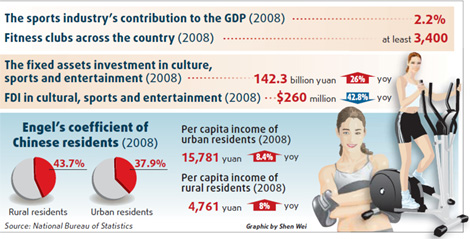

|
A fitness coach trains yoga students at an open site in Qinhuangdao near the Great Wall in North China's Hebei province. Yoga is becoming popular as more people strive to maintain good health. That's good news for the health and fitness business, too. Asianewsphoto |
Shu Ge, a 30-year-old public relations manager at an international retail company, started practicing yoga when she was four months pregnant. She went to a luxury yoga club in Beijing's Chaoyang district at least three times a week, which cost her 260 yuan per visit.
She kept it up until one month before giving birth to her daughter. And she cannot wait to return to the club.
"It is old-fashioned that pregnant women should stay in bed before and after pregnancy," Shu said.
"I cannot tolerate it at all if I'm out of shape, so I choose yoga as a healthy and safe way to not only keep fit, but also help maintain a good state of mind," she said.
As fashion and health awareness expand in China, people's desire to stay slim and trim also is growing.
China has become the world's largest commercial fitness and leisure market with more than 400 million potential consumers ages 18 to 50.
Besides, according to leading health experts, an estimated 200 million Chinese will face obesity challenges in the next 10 years - a trend that also might fuel market demand for health and fitness clubs.
The market is developing fast. In 2007, the number of fitness clubs in China totaled 2,500, including 465 in Beijing. The size of the Chinese fitness market was estimated at about $10 billion to $15 billion.
With China's fast-growing economy, there is also extra consumer money to spend. Spending on sports and other recreational equipment leaped 8.5 percent in the first half of 2008, compared with the same period in 2007, to 10.3 billion yuan, according to government figures.
Post-Olympics boom
Industry experts attributed the boom to the 2008 Beijing Olympic Games.
Since the Olympics ended, statistics show that the number of fitness clubs in China now exceeds 3,400.
After a stressful 10-hour workday, Song Bingbing, a 29-year-old IT engineer, went straight to the gym to work out for two hours.
He has a personal trainer that costs him 280 yuan a session in addition to the 1,500 yuan annual membership fee.
"It is actually a large amount of spending for me, since I only earn 3,500 yuan a month," Song said.
But it is worth it, Song said, "I used to weight over 80 kg, but now I'm only 65 kg," he said.
"I come here to be healthy. Since I started going to the gym, I found I've become more energetic at work," Song said. "And, I have more confidence when I'm facing my boss and colleagues."
Lower fees
Here is a piece of good news for Chinese exercisers who, like Song, are not wealthy.
About a decade ago, fitness club membership was regarded as a luxury and also a symbol of the upper class. Clubs were located at four-star or five-star hotels, and the cost of membership was 10,000 yuan a year or more.
In the past two years, with the rapid growth of Chinese fitness clubs and also competition, many Chinese fitness club operators have had to cut the price of membership and offer more discounts.
Famous fitness club brands like Hokay, Zhangbei and CSI-Bally Total have had to follow the suit -- especially considering the global economic recession.
Zhou Fen, a business school student, paid 1,500 yuan for a two-year membership at Hokay last August. Her friend only paid 1,100 yuan this year for the package, she said.
The price of membership at Nirvana Fitness, which used to focus on the high-end fitness market, has decreased to 5,000 yuan or less in Beijing.
An industry insider said that among the 1,000 newly established fitness clubs in the past year, 600 to 700 clubs might soon be forced to close down because of the long gap between huge initial investments and a return on those investments.
And the operators are also facing pressures from soaring land rents and personnel costs, he said.
China's relatively young fitness market also lacks the management experience found in other countries, insiders said.
"China provides a huge market, but it is in its infancy," said David Chan, who established Megafit, the first Chinese chain of fitness clubs in Shanghai, and is now a fitness consultant.
Wang Cheng, general manager of Nirvana, said the current price war will hurt the fitness industry as a whole, suggesting that relevant government agencies or industry associations bring operators together to discuss solutions.
Wu Shijun is a businessman who has been involved in China's fitness industry for the past decade.
"One of the answers for Chinese fitness club operators is to find their exact target consumers, and then work out relevant strategies along with services and products," Wu said.
A report published in Asian Social Science by Wan Bin of the Dalian University of Technology, described who joins fitness clubs in China today.
According to the report, business employees are the major customers, accounting for 35.7 percent of fitness club membership in 2007.
Self-employed professionals accounted for 23.7 percent, civil servants 7.4 percent and teachers 2.6 percent. Students accounted for 13.7 percent of fitness club memberships.

(China Daily 11/16/2009 page1)













